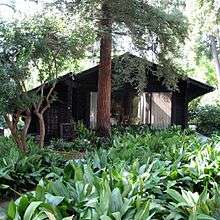Finnish Folk Art Museum
|
The Finnish Folk Art Museum | |
 Exterior of The Finnish Folk Art Museum, Pasadena, California | |
 | |
| Location | 160-170 N. Orange Grove Blvd., Pasadena, California |
|---|---|
| Coordinates | 34°8′56″N 118°9′37″W / 34.14889°N 118.16028°WCoordinates: 34°8′56″N 118°9′37″W / 34.14889°N 118.16028°W |
| Area | 2.6 acres (1.1 ha) |
| Built | 1910 |
| Architectural style | Swiss Chalet |
| NRHP Reference # | 85001983.[1] |
| Added to NRHP | September 5, 1985 |
The Finnish Folk Art Museum is located on the grounds of the Pasadena Museum of History in Pasadena, California. The only museum of its type in the United States, it was created in 1974 by Yrjo Alfred Paloheimo, a native of Finland, who was the husband of Leonora “Babsie” Curtin.[2]
Paloheimo served as Finland’s consular officer in Southern California, Arizona, and New Mexico. For 17 years, Finland’s consulate offices were located in the mansion. Paloheimo founded the Finlandia Foundation and established Jawanpaa, Finland, as Pasadena’s sister city in that country.[3] He and his wife also adopted four Finnish children who were reared on the Fenyes Estate.[4]
The Swiss chalet-like structure, constructed of redwood with a stone roof, was built in 1910 as a garage for Arthur Fleming’s Wigmore Estate. Fleming’s architect, Frederick Roehrig, also designed portions of the Green Hotel in Pasadena. In 1949 Paloheimo learned that the unusual structure was for sale, and moved it onto the grounds of the Fenyes Estate to serve as a folk art museum, guest house, and sauna. Paloheimo filled the building with farmhouse furnishings he collected from several provinces in Finland, and did much of the stone work and gardening himself.[5]
Inside the museum, a large living room called a “Tupa” is furnished with early 19th Century Finnish peasant furniture and objects. Visitors may see an open hearth or “Takka” used for heating and cooking, poles and overhead racks called “Leipavartaat” for storing rye sourdough bread, and “Tuoli” or chairs hand-carved by farmers as bridal gifts to their daughters, as well as many other Finnish hand-made items.[6]
The Finnish Folk Art Museum and Finlandia Gardens were officially dedicated in 1974. Currently maintained by the Pasadena Museum of History, tours of the folk art museum are often included in Feynes Estate tours[7]
References
- ↑ National Park Service (2010-07-09). "National Register Information System". National Register of Historic Places. National Park Service.
- ↑ "Pasadena Museum of History". Pasadena Museum of History. Retrieved May 30, 2015.
- ↑ "Finlandia Foundation National". Finlandia Foundation National. Retrieved June 8, 2015.
- ↑ Fenyes Mansion Docent Manual. Pasadena Museum of History. March 2008. p. 40-41.
- ↑ Fenyes Mansion Docent Manual. Pasadena Museum of History. March 2008. p. 39-40.
- ↑ Saraii, Jon L, (2003). Black Ties and Miners’ Boots: Inventing Finnish-American Philanthropy: A History of Finlandia Foundation. Finlandia Foundation.
- ↑ "Pasadena Museum of History". Pasadena Museum of History. Retrieved June 9, 2015.